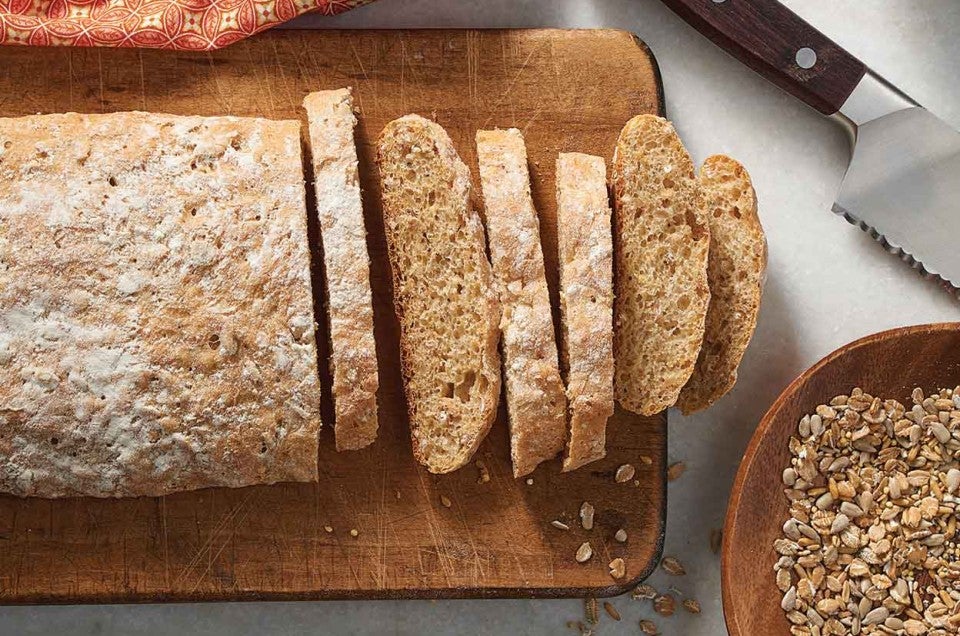


Whole-grain ciabatta. Does this sound oxymoronic, or what? I mean, ciabatta is the queen of crusty white-flour breads; a baguette gone round-shouldered and soft-edged. It’s the epitome of light texture; the antithesis of the sometimes heavy, somewhat dense texture we associate with whole-grain breads. Whole-grain ciabatta—why go there?
Back in late September, when I posted a recipe for traditional all-purpose flour ciabatta, one reader made a request for a whole-grain version. “My favorite ciabatta is a multigrain one at our local Hy-Vee grocery. What would you do to make your recipe with whole grains or as high a proportion as possible?” wondered Mary Cay.
We in the test kitchen here at King Arthur Flour are always up for a challenge. Whole-grain ciabatta? Hmmm… interesting.
As it happens, the Italians DO make whole-grain ciabatta. Called ciabatta integrale (integrale = “with everything”), we have a recipe for it in King Arthur Flour Whole Grain Baking. But I wanted this new version to include some Harvest Grains Blend, our crunchy-chewy-nubbly combo of seeds and whole grains. And I wanted the bread to be a bit lighter, a bit milder. So to make the dough rise acceptably, I used a 2:1 ratio of all-purpose to whole wheat flour; then added the grains blend for a big, whole-grains mouth-feel.
The result? Let me know, Mary Cay. It’s not exactly what I’d consider ciabatta, but it’s a remarkably light-textured whole-grain loaf.
Determined to bake whole-grain bread? Give this Harvest Grains Ciabatta a try.
First we're going to make a starter from King Arthur Golden Wheat Flour, which happens to be my favorite whole wheat flour. What's the difference between golden wheat and traditional red whole wheat? Nothing, nutritionally; they're identical in all respects except one: red wheat has a compound in its bran layer that gives it a darker color and stronger taste. Some perceive this stronger taste as unpleasant; some like it. I'm in the former camp, so I opt for golden flour when I'm using whole wheat.
Mix golden wheat flour, cool water, and yeast to make a pasty dough. Cover, and let rise overnight at room temperature.
Next day, you'll see that the starter has risen and become bubbly, though not with the vigor of a white flour starter. It's OK; the yeast is just as happy (happier, actually) growing in whole wheat as white flour. It's just that the whole wheat doesn't capture as much of the yeast's CO2 as white flour does.
This is a sticky dough, so you want to make it in a stand mixer or bread machine, as I'm doing here. Let me show you why I nearly always make dough in the bread machine (when I'm not making it in the stand mixer for blog photos). If you don't have a bread machine, at least take a quick look as you scroll down to the mixer pictures; hey, maybe I can sell you on a bread machine!
First, put the starter and the remaining dough ingredients (EXCEPT the Harvest Grains Blend) into the bread machine bucket.
Press the Start button. Walk away. After 5 minutes, the dough will look like this.
After 10 minutes, about like this.
Here it is when the signal tells you to add the Harvest Grains Blend. BEEP. OK, grains about to be added.
Five minutes later, the grains are nicely kneaded in.
An hour later, the dough is risen, ready to shape. Was that easy, or what?!
If you like, program the machine for its regular cycle (rather than the dough cycle), and let the bread bake right in the machine. Not bad, huh?
OK, let's go back to our stand mixer. Here's why you wait till after the dough is kneaded to add the Harvest Grains Blend. There's something in the flaxseed, I believe it is, that makes this dough INCREDIBLY sticky if you add the grains right at the outset.
It was kind of laughable, really. I was going to take a picture, but my fingers got so stuck together I had to go roust Susan away from the cake she was making to take this picture. PHEW! Learned my lesson on that one.
Here's the dough, mixed and kneaded in a stand mixer.
NOW add the Harvest Grains Blend.
Much better.
Put it in a covered container to rise at room temperature for 90 minutes or so.
It'll get nice and puffy.
Divide the dough in half, and shape each half into a 10” log. Place the logs on a lightly greased or parchment-lined baking sheet, leaving plenty of space between them. Cover and let rise for 60 to 90 minutes.
They'll puff up nicely.
Spritz with water just before baking. This helps give the ciabatta a crisp crust.
Bake, cool, slice, enjoy.
Note the lovely open texture and the nubbly look of seeds and whole grains. This bread's a looker, for sure—AND it tastes good.
Read, rate, and review (please!) our recipe for Harvest Grains Ciabatta.

